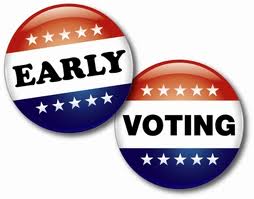Democratic primary voters surged to the polls in Harris County on Friday, surpassing turnout from 2016 but falling well short of their record-setting performance in 2008.
Republican primary voters, meanwhile, turned out in larger-than-expected numbers thanks to a handful of high-profile congressional and legislative contests. The result also could signal early enthusiasm among GOP voters for President Donald Trump’s re-election, experts and political strategists said.
A total of 139,533 Democratic primary voters returned mail ballots and voted in person across the 11-day early voting period that ended Friday. Though turnout did not match the roughly 177,000 early votes from Harris County’s 2008 Democratic primary, it easily outstripped 2016, when turnout reached 85,793.
“The turnout has been healthy but not historic, especially compared to 2008 when the numbers were massive,” said Brandon Rottinghaus, a political science professor at the University of Houston. “That’s a good sign for Democrats, but it doesn’t signal tremendous growth in the Democratic electorate.”
The fluid state of the Democratic presidential primary may have dampened early voting turnout, with some voters awaiting results from Saturday’s South Carolina contest. The candidacy of former Vice President Joe Biden is said to hinge on a strong showing there, while other lower-performing candidates could drop out between South Carolina and Super Tuesday, when Texas and 13 other states will hold their primaries.
The Republican primary, meanwhile, totaled 104,909 early and mail ballots — a massive uptick from the 2018 midterm cycle, but well below the roughly 131,000 who turned out early for the 2016 Republican contest.
Here are your final numbers. Here’s the Day Eleven report for 2020, and here are the totals from 2012, 2016, and 2018. The totals after early voting ended:
Year Mail Early Total
==============================
2008 9,448 169,900 179,348
2012 7,735 30,142 37,877
2016 13,034 72,782 85,816
2018 17,744 70,172 87,916
2020 22,785 116,748 139,533
2008 15,174 51,201 66,375
2012 17,734 60,347 78,081
2016 20,780 110,365 131,145
2018 20,075 61,462 81,537
2020 22,801 82,108 104,909
The 2008 numbers come from the County Clerk historic results. It seems highly unlikely that Dems are going to get to my original over/under line of 500K, but 400K is still within reach. Remember that historically speaking, there’s likely still a lot of votes to be cast. If 61.5% of the total Democratic primary vote is cast on Tuesday, as it was in 2016, then final Dem turnout will be about 366K, with 223K of it being cast on Primary Day. There were 231K votes cast on Primary Day in 2008, with far fewer registered voters, so this is certainly within reach. To get to 410K, the high-water mark of 2008, about 64% of the total vote would need to be cast on Tuesday. I think that’s doable, but I was overly optimistic at the beginning of this cycle, so let’s try not to repeat that mistake. Dems should have no trouble surpassing the 227K total turnout from 2016, so at the very least this will be the second-heaviest primary this century so far.
Republicans have had a good showing as well, better than I would have expected. However:
For Republicans (104,506 in-person & mail voters):
4% under 35
10% 35-49
30% 50-64
56% 65+51% women
49% men1% African American
6% Latinx
3% Asian American
89% white
1% unknown15% voted in 0 of last 3 primaries
20% voted in 1 of 3
27% voted in 2 of 3
39% voted in 3 of 3— Keir Murray (@houtopia) 2:18 PM – 29 February 2020
Much more of the Republican electorate so far has been their old faithful, while a much bigger share of the Dem primary has been people with less of a Dem primary voting history. That said, given that the last three primaries were 2014, 2016, and 2018, there are fewer Dems who could have voted in all of those primaries since only 54K did so in 2014, while Republicans have had at least 139K from each of those years. Point being, the pool of folks who have voted in at least two of the last three Republican primaries is quite a bit bigger than that same pool for Dems. That makes this sort of number more fun than informative.
More importantly, we can all agree that the number of Democrats who have shown up in November has been quite a big larger than the number of Republicans in Harris County in recent years. Primary turnout has no real correlation to November turnout – there’s just too much variance, and the sample size is too small. Remember, Republicans crushed Democrats in primary turnout in 2016 (329K to 227K) and were near parity in 2018 (156K to 167K), and we know how those years ended up.
Finally, using the Secretary of State turnout tracker, 1,085,065 Republicans had voted early in the primary, while 1,000,231 Dems had done so with a couple of smaller counties still unaccounted for as of Saturday lunchtime. As with Harris County, I clearly underestimated Republicans statewide, but Dems are in position to at least come close to the historic 2008 numbers. The SOS doesn’t maintain early voting statewide numbers so I can’t say what the past looked like as I can for Harris County, but I’d say two million total is well within reach, and 2.5 million is possible. I’ll try to take a closer look at some of these numbers for tomorrow. Let me know what you think. Have you voted yet?


Is the “voted in _ of last 3 primaries” in Dem primaries or all primaries? I’m assuming the former.
Dem primaries in that context, GOP primaries in that context. It’s just showing how many of those voters are the usual suspects.